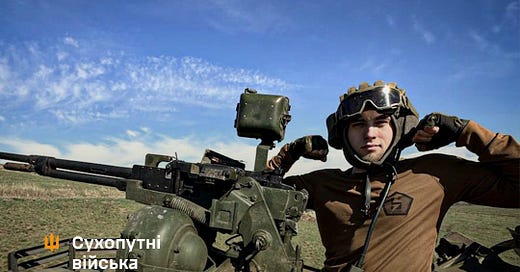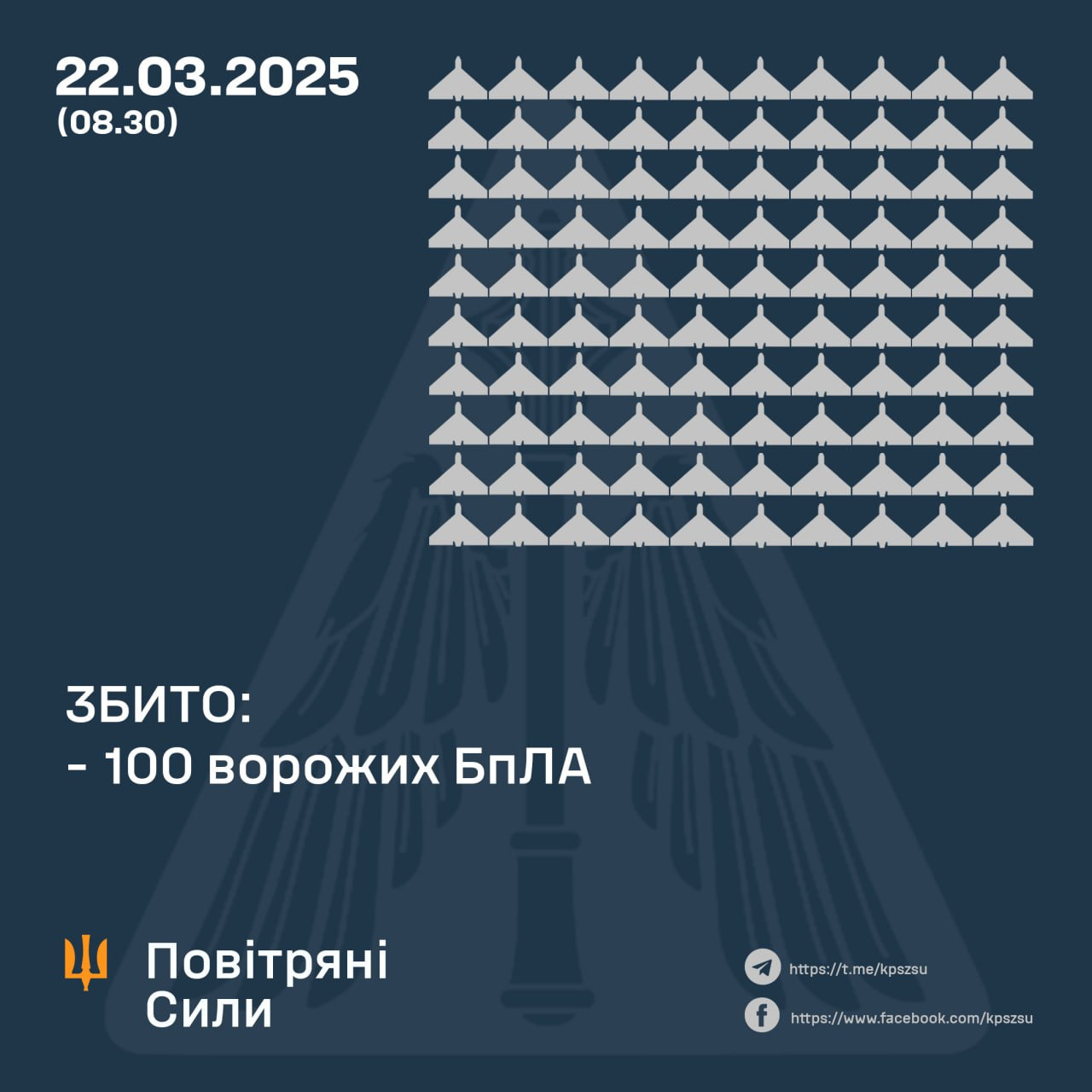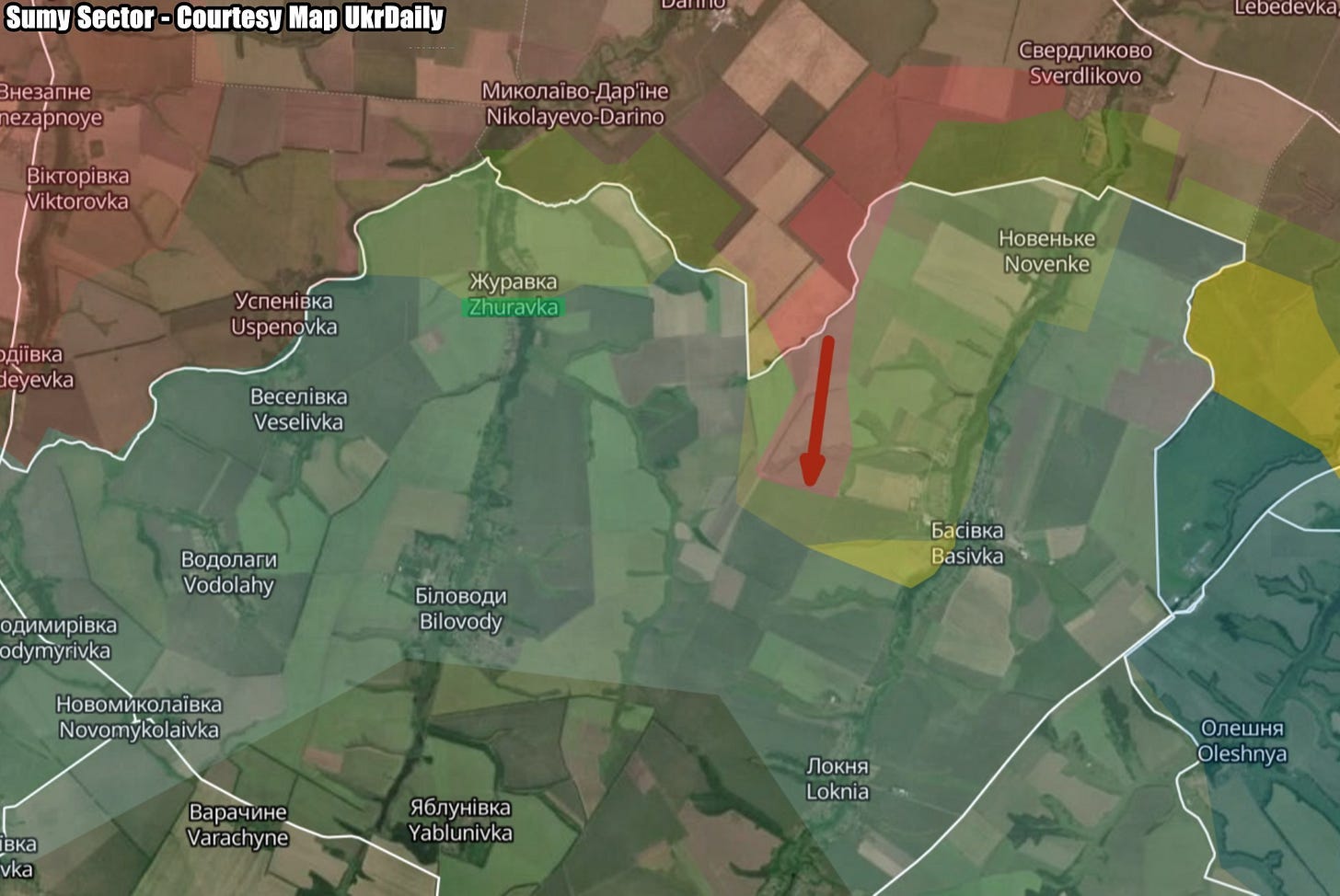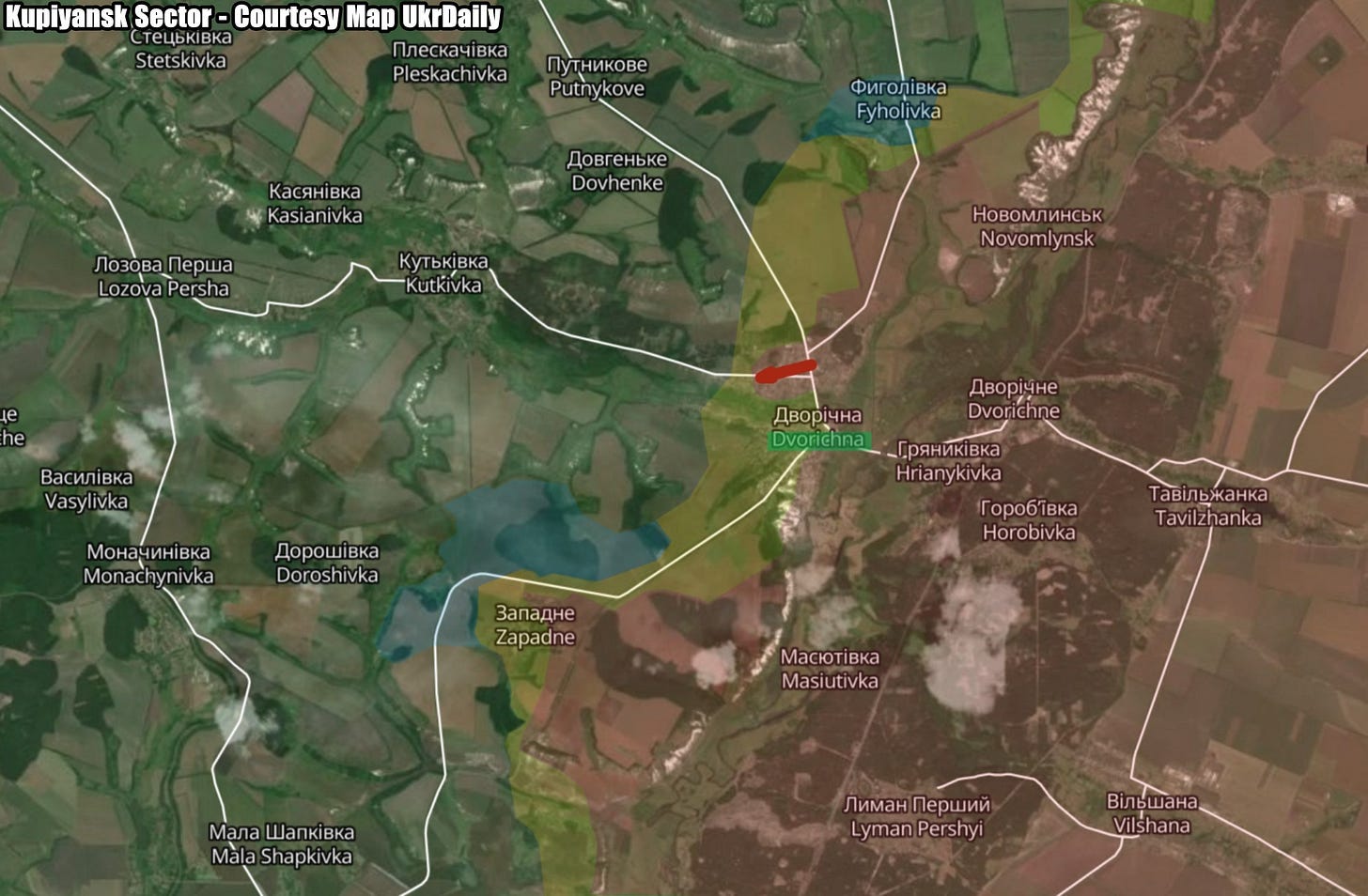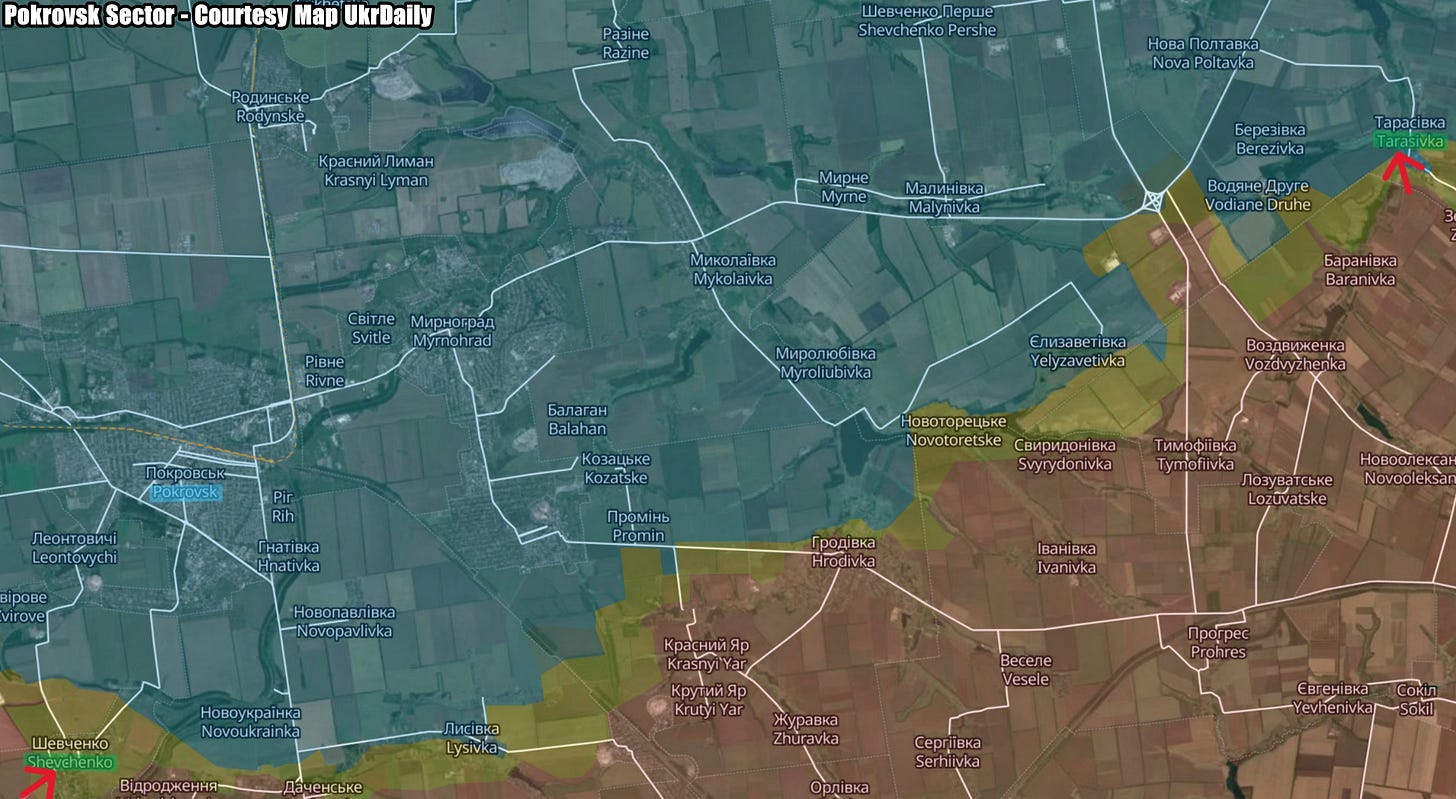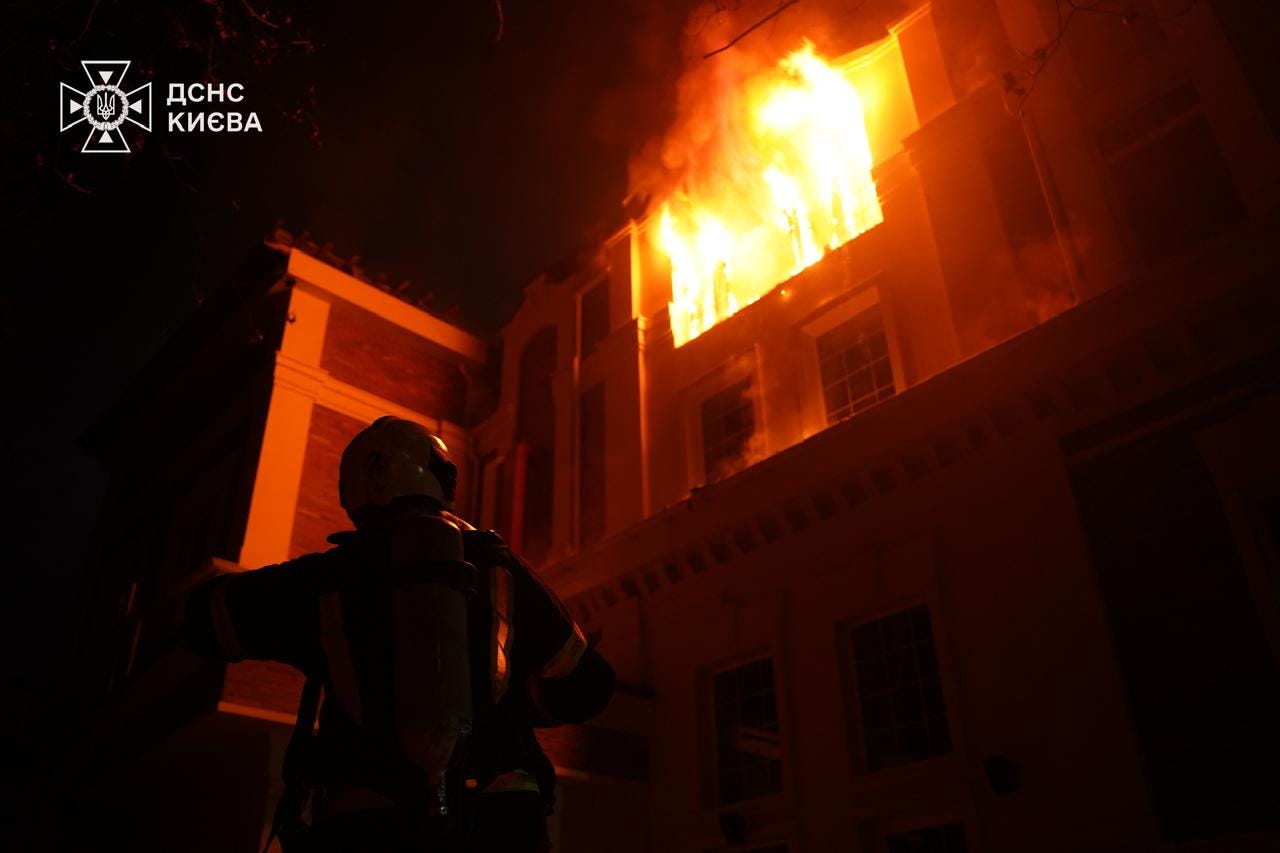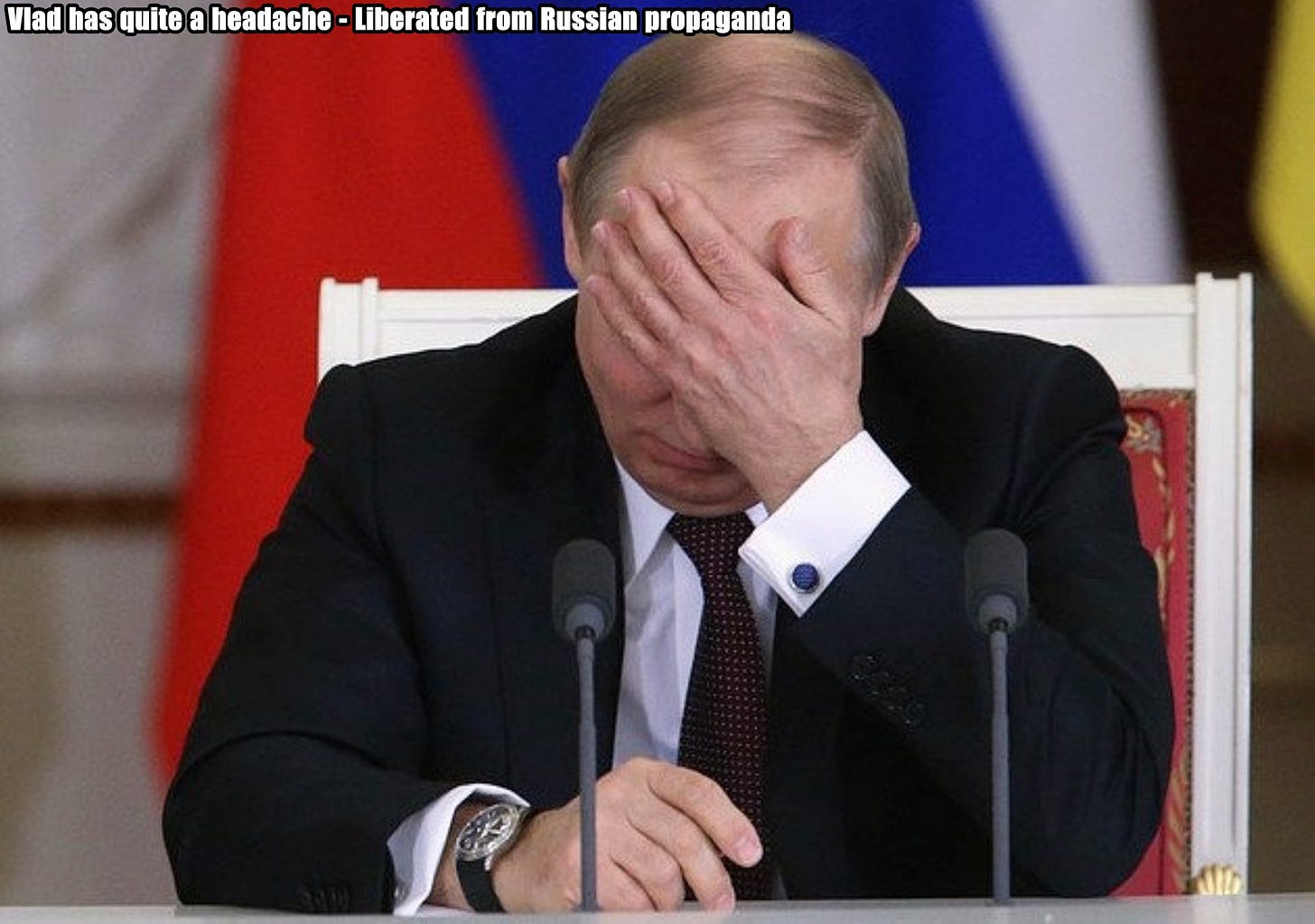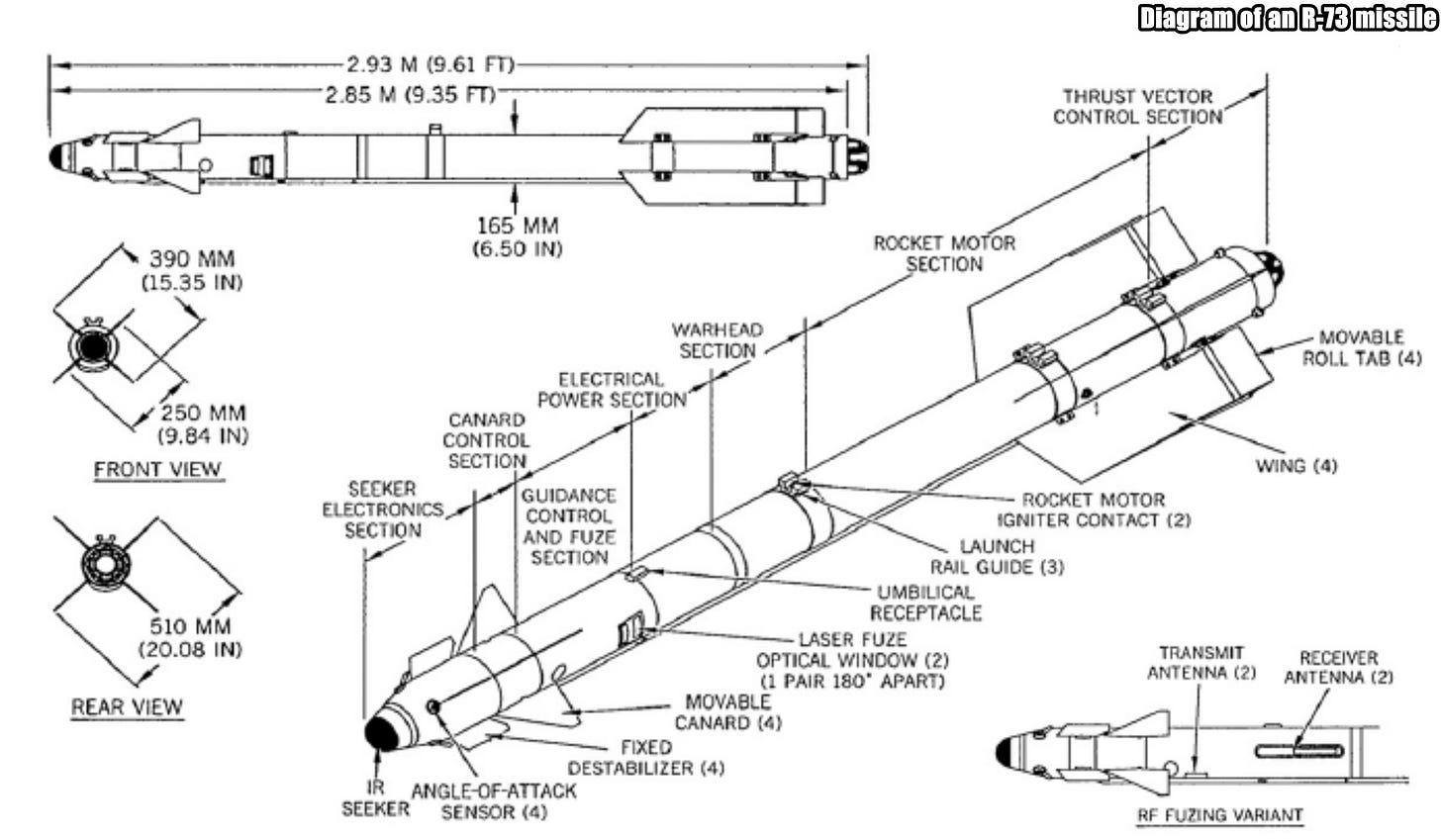Slava Ukraini! In early 2022 I began a Telegram channel aggregating news from a number of sources daily on the war in Ukraine. In June 2023 I began providing a daily draft for the Ukraine War Brief Podcast collecting news from over 70 sources daily, which formed the basis of the script. While the Podcast no longer exists I have continued to make this Brief available for my followers here on Substack for those who wish to keep up with the news from the war.
All the latest news on the Russo-Ukraine War 6 days per week
ALONG THE CONTACT LINE
GSAFU Morning Report
For: Mar 22, 2025
The General Staff of the Armed Forces of Ukraine in its Operational Information update at 08:00 on Mar 22 stated that day 1123 of the full-scale invasion of the Russian Federation against Ukraine had begun.
The situation on the line of combat remains tense in some sectors. Ukrainian defenders continue to actively counteract the Russian aggressor, causing them significant losses in personnel, equipment and technology. Exhausting the enemy along the entire front line and continuing to disrupt the plans of Russian occupiers to advance deeper into the territory of Ukraine.
During the past day, 142 combat engagements took place.
Over the past 24 hours, the enemy carried out 1 missile strike, 85 air strikes, used 3,000 drones and fired approximately 6,l400 artillery shells across the positions of Ukrainian forces and civilians.
Air Force Daily Report
100 ENEMY UAVS SHOT DOWN, 63 SIMULATOR UAVS FAILED TO REACH THEIR TARGETS (LOCATIONALLY LOST)
➖➖➖➖➖➖➖➖➖
On the night of March 22, 2025 (from 7:30 p.m. on March 21), the enemy attacked with 179 Shahed attack UAVs and simulator drones of various types from the directions: Millerovo, Primorsko-Akhtarsk - Russia, Chauda - Crimea.
The air attack was repelled by aviation, anti-aircraft missile troops, electronic warfare units, and mobile fire groups of the Air Force and Defense Forces of Ukraine.
As of 08:30, it has been confirmed that 100 Shahed attack UAVs and other types of drones have been shot down in the south, north, and center of the country.
63 enemy drones-simulators - lost in location (without negative consequences).
Zaporizhzhia, Kharkiv, Sumy, and Kyiv regions were affected by the Russian attack.
Combat Operations in the Russian Federation
Kursk Salient: The Institute for the Study of War (ISW), a US based think tank, in its Mar 21 Russian Offensive Campaign Assessment reported that Russian forces continue to attack limited Ukrainian positions in Kursk Oblast, although Russian advances have slowed in recent days.
Russian milbloggers recently noted that intensified Ukrainian HIMARS strikes are complicating Russian efforts to push Ukrainian forces from their remaining positions south of Sudzha.
Belgorod Incursion: Ukrainian forces recently marginally advanced in western Belgorod Oblast.
Assessed Ukrainian advances: A Russian milblogger published a map on March 20 acknowledging that Ukrainian forces advanced in the fields southwest of Demidovka (northwest of Belgorod City along the international border).
The Khortytsia operational-strategic group
(Responsible for the northeastern part of Ukraine. )
Sumy Sector: Russian forces advanced in northern Sumy Oblast.
Footage published on Mar 12 and geolocated on Mar 20 indicates that Russian forces advanced west of Zhuravka (north of Sumy City), but this advance did not occur in the last week.
Kupyansk Sector: Russian forces recently advanced in the Kupyansk direction.
Geolocated footage published on March 21 indicates that Russian forces recently advanced in southern Dvorichna (northeast of Kupyansk).
Toretsk Sector: Russian forces recently advanced in the Toretsk direction.
Geolocated footage published on Mar 20 indicates that Russian forces recently advanced along Enhelsa and Mykhaila Hrushevskoho streets in central Toretsk.
The Tavria operational-strategic group
(Responsible for the central-eastern and southeastern part of Ukraine.)
Pokrovsk Sector : Russian forces recently advanced in the Pokrovsk direction.
Geolocated footage published on Mar 20 indicates that Russian forces recently advanced within southwestern Tarasivka (east of Pokrovsk) and eastern Shevchenko (south of Pokrovsk).
The Odesa operational-strategic group
(Responsible for Kherson, Qırım, (also known as Crimea) and the Black Sea.)
There have been no major changes to the combat environment since our last report.
TEMPORARILY OCCUPIED TERRITORIES
2 Russian officers allegedly killed in car bombing in occupied Skadovsk.
A car with two Russian officers exploded on Mar 20 in the Russian-occupied town of Skadovsk in Kherson Oblast, Ukrainian military intelligence (HUR) said on Mar 21, the Kyiv Independent reports.
Skadovsk, a city with a pre-war population of 17,000, lies on the Black Sea coast. Russia has occupied it since March 2022.
According to the statement, the explosion occurred at 8:40 p.m. local time on Myr Street. "A pile of warped metal remained" from the Nissan car, which reportedly carried two Russian officers, HUR said.
Russia declared annexation of partially occupied Kherson, Zaporizhzhia, Luhansk, and Donetsk oblasts in September 2022, a step denounced by Ukraine and the international community as illegal and void.
Russian officials, their proxies, and collaborators have been routinely targeted in both occupied parts of Ukraine and inside Russia. Kyiv does not typically comment on the attacks or claim responsibility.
THE HOME FRONT
6 killed, 36 injured in Russian attacks against Ukraine over past day.
At least 6 people were killed and 36 others injured in Russian attacks across Ukraine over the past day, the Kyiv Independent reported citing regional officials on Mar 22.
In Zaporizhzhia Oblast, a family of three were killed in the Shakhed drone attack on the city of Zaporizhzhia overnight, including a 14-year-old girl and her parents, Governor Ivan Fedorov reported. Twelve more people were wounded.
"Russia has once again killed a 14-year-old child in Zaporizhzhya with a Shakhed. Russia must stop all strikes," wrote the head of the President's Office, Andriy Yermak, on Mar 22.
Two people were killed in Kostiantynivka and Fedorivka in Donetsk Oblast due to Russian shelling, Governor Vadym Filashkin said. Nine more people were wounded. In total, Russian forces shelled the settlements 22 times on March 21.
In Kherson Oblast, one person was killed and fourteen were injured as Russian forces shelled residential areas, and social facilities, according to Governor Oleksandr Prokudin.
In Dnipropetrovsk Oblast, a 14-year-old boy was wounded in a drone attack near Mezhova, Governor Serhii Lysak reported. Russia also attacked Marhanets with Grad multiple rocket launchers, heavy artillery and drones, damaging local entreprises and residential houses.
Russia also shelled Mykolaiv, Sumy, Kharkiv and Kyiv oblasts over the past day, according to local authorities.
RUSSIAN WORLD
Putin Warns Business Leaders of ‘Slow and Difficult’ Ukraine Ceasefire Talks.
President Vladimir Putin told Russian business leaders in a closed-door meeting not to expect a quick peace deal with Ukraine, journalist Farida Rustamova reported for the Moscow Times Thursday, citing anonymous sources who attended the meeting
Business executives and government officials who participated in Tuesday’s annual congress of the Russian Union of Industrialists and Entrepreneurs, a major business lobby, reportedly concluded from Putin’s remarks that U.S.-mediated negotiations would be “difficult and slow,” despite the Trump administration’s optimistic public statements.
“This [war and sanctions] machine won’t be that easy to turn around,” one attendee was quoted as saying after the private session.
The source described Putin’s demeanor as “positive but objective,” lacking “unbridled optimism” about a quick ceasefire or the lifting of sanctions.
Putin’s reported comments came ahead of a scheduled phone call with U.S. President Donald Trump Tuesday evening. Following their conversation, the Russian leader agreed to a 30-day pause on attacks against energy infrastructure but stopped short of accepting a broader ceasefire in the war.
“The president advised us not to be naive and to understand how many people and interests are involved in the processes currently taking place,” Rustamova quoted another source as saying.
A third attendee said Putin believes that even if sanctions are lifted, “the United States and the West would figure out how to pressure us anyway.”
Rustamova’s report follows reporting from the Kommersant business newspaper, which suggested that Putin intends to continue pursuing territorial gains in Ukraine, as Russian forces “don’t have time to dig in.”
According to Kommersant, Putin is pushing Trump to recognize Russia’s annexation of Ukraine’s Kherson, Zaporizhzhia, Donetsk, Luhansk and Crimea regions in exchange for Moscow’s agreement not to lay claim to additional territory.
RELATED INTERNATIONAL NEWS
Zelensky, Pavel meet in Kyiv to discuss security guarantees for Ukraine.
President Volodymyr Zelenskygy discussed the war with Russia and European efforts to provide security guarantees for Ukraine during the meeting with his Czech counterpart Petr Pavel in Kyiv on Mar 21, the Kyiv Independent reports.
Pavel arrived in Kyiv earlier in the day. The day prior, the Czech president met with Deputy Prime Minister for Development of Communities and Territories Oleksii Kuleba, among other Ukrainian officials, in Odesa.
During Pavel's visit to Odesa, Russia launched Shahed-type drones at the city. Three people were injured during the attack, and civilian infrastructure was damaged.
Pavel and Zelensky discussed the situation on the front line, European efforts to gain security guarantees for Ukraine, and cooperation in defense production.
The Ukrainian president also thanked Pavel for the Czech contribution to the UK-led "coalition of the willing."
The parties also agreed to open a Unity Center for Ukrainians in Prague.
"Thank you for your visit and cooperation. Today, we signed a joint statement on strategic partnership between our countries. This reflects the real level of our relations. Thank you for this. Thank you for the Czech initiative and for all the help you have given to our people," Zelenskyy said.
The Czech Republic has been one of the most committed supporters of Ukraine since the beginning of Russia's full-scale invasion in Feb 2022.
In July 2024, Ukraine and Czechia signed a 10-year bilateral security deal.
According to the agreement, Czechia and Ukraine are expected to boost cooperation in the military tech sphere, including the production of ammunition, small arms, drones, electronic warfare, and heavy equipment.
The two countries also plan to set up joint enterprises and continue annual training of up to 4,000 Ukrainian military personnel.
Macron exploring UN alternative to Starmer’s Ukraine plan.
Emmanuel Macron is actively exploring alternatives to putting European boots on the ground in Ukraine – his plan drawn up with Sir Keir Starmer, the Telegraph reports.
The Telegraph understands that the French president is considering the possibility of a mission to protect a future peace deal being led by the United Nations.
Macron reportedly raised the idea of a UN-backed alternative during a European Council summit, where he discussed the concept with UN Secretary-General Antonio Guterres.
The proposal would align with traditional UN peacekeeping operations, which typically involve deploying multinational forces to maintain security, protect civilians, and facilitate humanitarian aid in conflict zones.
Any UN peacekeeping force would require approval from the UN Security Council, where Russia holds veto power. Given Moscow's opposition to foreign troops in Ukraine, the likelihood of securing a UN mandate remains slim.
U.S. President Donald Trump claimed on Feb. 24 that Russian President Vladimir Putin would allow European peacekeepers to operate in Ukraine as part of a settlement, though Russian Foreign Minister Sergey Lavrov publicly rejected the idea.
Over 30 countries have expressed willingness to contribute to the coalition's peacekeeping force, Starmer's spokesperson said on March 17, confirming that the initiative has moved into an "operational phase."
British military leaders have considered deploying Royal Air Force (RAF) fighter jets as part of a potential security arrangement, the Telegraph reported on Mar 20.
MILITARY & TECH
Ukraine's New Close-Range Air Defense System.
A new ground-based air defence system with R-73 air-to-air missiles has surfaced in possession of the Ukrainian Defense Forces, continuing the broader trend of integrating this missile, Defense Express reports.
Maksym Zaichenko, a serviceman of the 3rd Army Corps (formerly the 3rd Assault Brigade), has published photos on Facebook showing an interesting air defense system that has appeared in public for the first time.
The system’s defining feature is its use of R-73 short-range air-to-air missiles, mounted in a twin-launcher configuration on the truck bed of a vehicle that seems to be an armored HMMWV, as indicated by the placement of metal arcs for mirrors and the wiper arrangement. There's also an electronic warfare system for protection against FPV drone attacks.
Apparently, the photograph was taken around summer, suggesting that the system has been in service for a while now, even though it has never been caught on camera.
The new air defense system bears some resemblance to the American M1097 Avenger, which employs FIM-92 Stinger missiles and, in some configurations, a 12.7 mm Browning machine gun. The Armed Forces of Ukraine are well familiar with these vehicles and use them to shoot down UAVs, intercept missiles, and ambush low-flying aircraft. Much like the Avenger, the new system will likely perform similar functions.
Launching such missiles requires the homing seeker to lock onto a target before launch. It requires very precise positioning and continuous tracking until firing. The exact control mechanism of the Ukrainian system remains unknown; it could involve direct operator control, as seen in the MIM-72 Chaparral, or a more advanced remote-control system with electro-optical targeting.
A broader trend has emerged in adapting R-73 missiles for ground-based air defense. The United Kingdom has developed the Gravehawk system specially for Ukraine, while Ukrainian forces have integrated R-73 missiles into Soviet-era Osa launchers and even mounted them on Magura V5 unmanned surface vessels. The newly revealed system adds to this expanding list of adaptations within the 3rd Army Corps.
Additionally, the Norwegian company Kongsberg is planning to integrate an unspecified Ukrainian missile into the NASAMS surface-to-air system. While the exact model has not been disclosed, the R-73 is a strong candidate. All this implies that, firstly, this missile has proven itself effective, and secondly, there's no shortage in supply.
There is no confirmed data on the engagement range of these adapted surface-launched R-73 systems. However, in its original air-to-air role, the R-73 has a range of 20 to 40 km, depending on the variant. When launched from the ground, its range would be significantly reduced.
The new SAM uses R-73 missiles without such a booster, the operating range will be more modest. Possibly, Ukrainians have upgraded the missile to increase the range.
The R-73s featured in the photo appear to not have such modifications, so they should have a more limited range. Or, Ukrainians could have upgraded the missile in a different way to increase the range.
After all, upgrades and modernizations have progressively extended the range of the AIM-9 Sidewinder, a comparable U.S. missile. Early versions from the 1950s had a range of just 5 km, while later variants like the AIM-9M (introduced in the 1980s) reached 20 km, up to 30 km in the most modern AIM-9X iteration.
Ukrainian forces invent device to neutralize Russian KAB bomb sights.
The Ukrainian military has deployed a new Night Watch Lima jammer that disrupts satellite signals, causing Russian guided bombs to lose their orientation, Bild reported on March 22.
Russia has been regularly raining down cascades of aerial bombs on Ukraine over the past year. These satellite-guided missiles can fly up to 40 kilometers and hit their targets accurately. But that is changing: the bombs are increasingly missing — and sometimes even landing on Russian territory.
A source in Ukraine, who wished to remain anonymous, told BILD that Russia uses the Kometa-M system in its bombs, which combines several satellite signals and antennas. This makes it resistant to most standard jamming.
The Ukrainian Defense Forces have identified a vulnerability in the software of Russia’s Comet-M system, which is used in its bombs.
However, the Ukrainian military used a new Night Watch Lima jammer, which is capable of suppressing or replacing satellite signals, causing bombs to lose orientation in space. In addition, Ukrainian specialists, according to the source, are exploiting a vulnerability in the software of the Kometa-M system.
Military expert Thomas Tyner is confident that this technology gives the Ukrainian army a tactical advantage.
That’s it for today’s Brief folks if you would like to keep up with events in Ukraine daily please consider subscribing, it’s free!


